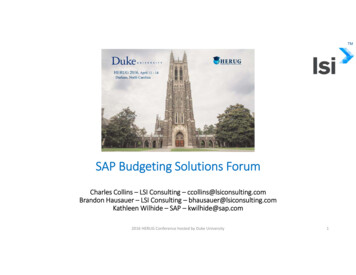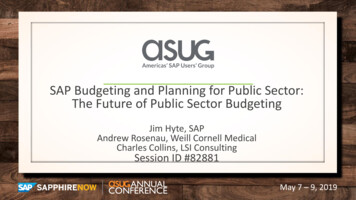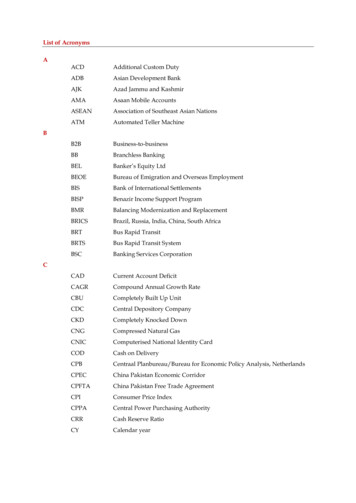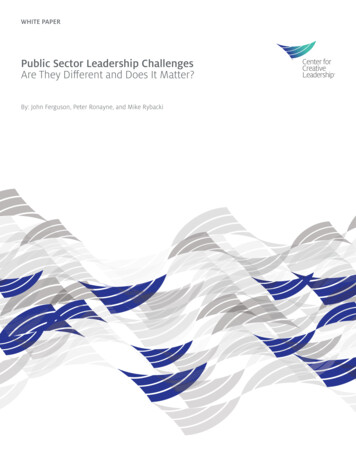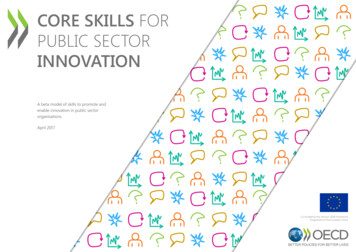
Transcription
CORE SKILLS FORPUBLIC SECTORINNOVATIONA beta model of skills to promote andenable innovation in public sectororganisations.April 2017Co-funded by the Horizon 2020 FrameworkProgramme of the European Union
This work is licenced under the terms of the CreativeCommons Attribution-ShareAlike 3.0 IGO Licence.The Observatory of Public Sector Innovation collects andanalyses examples and shared experiences of publicsector innovation to provide practical advice to countrieson how to make innovation work.This project has received funding from the EuropeanUnion's Horizon 2020 research and innovationprogramme under grant agreement No 671526.This document and any map included herein are withoutprejudice to the status of or sovereignty over anyterritory, to the delimitation of international frontiers andboundaries and to the name of any territory, city or area.April 2017Core skills for public sector innovation: a beta model2
CORE SKILLS FOR PUBLIC SECTOR INNOVATIONApril 2017Core skills for public sector innovation: a beta modelBACKGROUND AND CONTEXT4SIX CORE SKILLS FOR PUBLICSECTOR INNOVATION8IterationData literacyUser 720PROFILING THE SKILLS OFGOVERNMENT INNOVATORS22EXPLORING ATTITUDES TO ANDEXPERIENCES OF USING INNOVATIONSKILLS IN AN ORGANISATION313
BACKGROUND AND CONTEXTTo meet today’s public policy challenges – continued fiscalpressures, rising public expectations, more complex publicpolicy issues – there is a crucial need to increase the level ofinnovation in the public sector. There is a fundamentalneed to increase the level of innovation within the publicsector of OECD countries and EU states if they are to meetthe challenges of the 21st century, a need which has onlybeen increased by the fiscal pressures placed on manystates by the 2008-9 crisis.At the OECD Observatory of Public Sector Innovation’sNovember 2014 conference “Innovating the Public Sector:From Ideas to Impact” – a forum that brought togetherministers, public sector leaders and innovators (both insideand outside the public sector) – four “calls to action” werepresented that needed to be urgently addressed topromote and enable public sector innovation. The first ofthese calls is about the skills and capabilities of officials.A specific focus on skills for innovationThe innovation framework developed by the OECD (Figure1) puts people at the centre of an innovative organisation.The capacities and competencies of individual civil servants,the way they are organised in teams and structured in thepublic administration that will likely determine how effectivethe public sector is at being innovative.Preliminary data from the OECD’s 2016 survey of StrategicHuman Resource Management practices in government(the SHRM Survey) indicates that innovation is among thehighest priorities for HR reform across OECD countries. In28 countries public sector innovation features ingovernment-wide strategic objectives, many are developinglearning and training programs for civil servants and civilservice leaders, and almost half of responding countriesinclude innovation-related concepts in their competencyframeworks.However, in many cases, the inclusion of innovation in HRMpolicies and practices does not often extend beyond apassing reference and does not expand in detail the specificskills and capabilities needed.While the OECD has done significant work on theinstitutions of government and rules and processes ofgoverning, we still know comparatively little about thewomen and men who work within these structures, theskills and knowledge they use, and what motivates them tocontribute. It is only now that the OECD has started tounpack the complex topic of skills and capabilities forpublic sector innovation – two particular projects in 2016have supported this work: a review of innovation skills forthe Chilean Laboratorio de Gobierno, and a work packagein the grant from the European Commission’s Horizon 2020research framework programme to the OECD Observatoryof Public Sector Innovation.The four calls to action for governments at the OECD’s 2014 conference “ Innovating the Public Sector”1. Focus on people – Governments must invest in the capacity and capabilities of civilservants as the catalysts of innovation. This includes building the culture, incentivesand norms to facilitate new ways of working.3. Working together – Governments must advance new organisational structures andleverage partnerships to enhance approaches and tools, share risk and harnessavailable information and resources for innovation.2. Put knowledge to use – Governments must facilitate the free flow of information,data and knowledge across the public sector and use it to respond creatively to newchallenges and opportunities.4. Rethink the rules – Government must ensure that internal rules and processes arebalanced in their capacity to mitigate risks while protecting resources and enablinginnovation.April 2017Core skills for public sector innovation: a beta model4
Figure 1: The OECD public sector innovation framework (people section highlighted)Towards an OECD model of skills for public sectorinnovationAt the May 2016 meetings of the OPSI National ContactPoints (NCP) and the Working Party on Public Employmentand Management (PEM) a joint session was held fordelegates to both groups on the topic of "Innovation Skillsand Competencies in the Public Sector". During the sessionthe OECD Secretariat presented initial work on a frameworkfor skills and competencies for public sector innovation, aswell as an update on the initial work on the ChileInnovation Skills Review. This alpha prototype, developed incollaboration with Nesta, presented over 40 attributesassociated with innovation skills and competencies groupedinto five broad areas.An interactive workshop was also included in the jointsession for delegates to test the alpha prototype in smallgroups and provide feedback to the Secretariat on its utility.At the conclusion of the joint session it was agreed that"the Secretariat will work to develop the skills mapping intoa more specific and practical tool which identifies specificskills needed for public managers to handle innovationprojects". To achieve this, the Secretariat has refined theinitial prototype into a beta-version model of skills forinnovation, which is the substantive focus of this paper.Alongside the beta model, and to support its development,the Secretariat commissioned Nesta to undertake researchApril 2017Source: OECD (2015) The Innovation Imperative in the Public Sector: Setting an Agenda for Actioninto the skills of innovators in government in the secondhalf of 2016. This research, the work to refine the model andother desk research have identified two broad groups ofindividuals in government that can be the focus of work onskills and capabilities for public sector innovation:“innovators coming into government” and “officialsbecoming innovators”.Many governments have made progress by bringing inexternal experts to set up new projects and inject newthinking – this comprises the first group outlined above,“innovators coming into government”. The key issues hereare how government can best utilise these people’s skills,motivate them, continue their professional developmentand reward their successes.However, just relying on bringing in external expertise isinsufficient to deliver a systemic change in the culture ofpublic sector institutions. To achieve the levels ofCore skills for public sector innovation: a beta modelinnovation needed requires not just bringing in 'new blood'but also ensuring that existing public servants have theskills and capabilities to support innovative practices ingovernment – or, as we title our second broad group,“officials becoming innovators”.Innovators coming into governmentThe research by conducted by Nesta for the Secretariatprovides a detailed exploration of the skills of innovationspecialists that have been brought into government fromoutside. The research used semi-structured interviews toexplore the in-depth the specific skills, education andbackgrounds of innovation specialists. A number of theseinterviews have been converted into eight “skills profiles”that provide a one-page overview of the skills andcapabilities of innovators working in different innovationroles within the public sector. These skills profiles areincluded at pages 22-30.5
Officials becoming innovatorsIn addition to the continued use of innovation specialistsand external experts, government increasingly need toimprove the skills and capabilities of existing staff. TheSecretariat’s work in this domain has been to refine theprototype framework of skills and competencies presentedto the PEM and NCP meetings in May 2016 into a betamodel that presents skills areas of “core skills” for publicsector innovation.These six skills areas are not the only skills for public sectorinnovation, each innovation project and challenge will haveits own particular needs. Nor will all public servants need tomake use of or apply these skills in every aspect of theirday-to-day job. Rather, these are six skills areas that withproper promotion/advocacy and development we believecan enable a wider adoption of innovation practices andthus an increased level of innovation. In fact, there are anumber of other skills that are already covered in existingpublic sector competency frameworks that are relevant forinnovation, such as collaboration, strategic thinking,political awareness, coaching.Leadership and management for public sectorinnovationAlongside specific skills that enable public sectorinnovation, our research has identified that mind-set,April 2017attitudes and behaviours can be just as important asspecific hard or soft skills in enabling innovation within thepublic sector. Beyond the focus of individual skills andcapabilities many research participants and stakeholdershave highlighted a number of other organisational factorsthat are also crucial for increasing levels of innovation in thepublic sector. In particular, leadership capability,organisational culture and corporate functions/systems(finance, HR, IT, legal) that are enablers of innovation not'blockers'. While outside the scope of the skills model, theseare important factors that need to be considered inoperationalising/implementing the skills model andachieving higher levels of innovation in the public sector.The exclusion of leadership and management capabilitiesfrom the beta skills model is neither an oversight norbecause they are not important. In fact, the contraryapplies, high quality leadership and management arecrucial for the success of public sector innovation,particularly in motivating and engaging employees todeliver in difficult/complex circumstances .However, over the course of the research and refinement aform or set of leadership and management capabilitieshave not emerged that are distinctly different from eitheran embodiment by leaders and managers of the skillsoutlined in the model or more ‘standard’ concepts ofleadership and management that are already espoused inCore skills for public sector innovation: a beta modelpublic sector competency frameworks (openness, honesty,trust, strategic thinking, staff development and capabilitybuilding). In addition to traditional arguments about“transformational” and “transactional” leadership, it hasbeen argued that “adaptive” and “pragmatic” leadership isneeded for public sector innovation 1: Adaptive leadership aims to determine whichpublic activities to maintain and which to adaptand transform. It then seeks to develop newpractices by crafting and testing prototypes andby aligning people across an organisation inorder to ensure effective execution and tofacilitate the integration of new activities with oldones. Pragmatic leadership aims to transform theculture of public organisations in ways thatenhance double loop learning and use existingtools to solve problems by changing establishedpractices – including transformative learning thatdevelops new metaphors and narratives that helpframe what is difficult to comprehend, expandknowledge and toolboxes and change identitiesand roles.1. Sorenson, E. and J. Torfing (2015), “Enhancing Public Innovationthrough Collaboration, Leadership and New Public Governance”, inNicholls, A., J. Simon and M. Gabriel (eds), New Frontiers in SocialInnovation Research, Palgrave Macmillan.6
A crucial role that leaders and managers need to play is tosupport and enable their team(s) to adopt more innovativeapproaches is to better manage the interface between theirteam(s) and the wider organisation that they operate in.While there is much similarity between any twoorganisations, each organisation has its own structure,culture and operating environment. What is needed ofleaders and managers to support innovation in oneorganisation may be different from that in another.For example, in one organisation leaders and managersmay need to focus on helping to unblock proceduralbarriers put in place by corporate functions (finance, HR, IT,legal, etc.) that stymy innovation, while in another settingthey may need to work to overcome silo-mentalities toenable two or more different teams to work together(either within the same organisation, or betweenorganisations). In these two situations there is a strongelement of mediation: defending the benefits of theirteam’s approach while fostering a spirit of collaboration bypragmatically identifying ways forward that overcome theimpasse.Another important role of all leaders and managers in thecivil service is to promote and advocate the work of theirteams. In discussions with their own managers and politicalleaders or during budgeting and strategic work-planningnegotiations, they need to communicate how the work ofApril 2017their teams is aligned with both organisational and widercross-government priorities/strategies.Similarly, when engaging with political leaders, seniorofficials need to be able to extol the virtues and benefits ofnew and different approaches and how innovation projectscan deliver a government’s political programme.Alternatively, some political leaders are strong advocates ofinnovation in the public sector; in this case, senior officialsneed to ensure that, while maintaining political support,politicians are understand the high-level uncertainties andrisks associated with individual projects.In reality, the collective leadership of both government andpublic sector organisations is likely to include a mix of thosewho are enthusiastic supporters of innovation, those whosupport it less strongly or are neutral, and those who aresceptical of public sector innovation. As with traditionalpolicy programmes, leaders and managers need to buildalliances to provide cross-government support, usingnatural cheerleaders to bolster support and provide anetwork of advocates across government.In all these situations the skills and capabilities required ofleaders and managers have no particularly distinct“innovation” component. However, when leading ormanaging an innovation team it might require a strongerapplication of leadership and management competencies,Core skills for public sector innovation: a beta modelbecause in doing something “innovative”, and which isdifferent from the usual way of doing things, they mayencounter stronger resistance than when they are initiatingor leading a more “traditional” project.Interaction with existing models and frameworks ofskills and competencies in the public sectorMany public sector institutions have their own skills andcompetency frameworks, which are used in a number ofpeople management functions such as performancemanagement, career development and recruitment. Theseframeworks may also be complemented or duplicated byframeworks from professional bodies (either internal orexternal bodies) that specialists are required to adhere to.As a result, some civil servants may find themselvesbeholden to several different frameworks of skills andcompetencies.The beta model outlined in this paper is not meant toreplace or duplicate existing frameworks but tocomplement them by providing a model of how skills forpublic sector innovation can be described. Officials in publicinstitutions can then choose whether to integrate theseinnovation skills into existing frameworks, or as astandalone model.7
SIX CORE SKILLS FOR PUBLICSECTOR INNOVATIONThe OECD’s beta skills model for public sector innovationhas been based around six "core" skills areas. Not all publicservants will need to make use of or apply these skills intheir day-to-day job. However, for a modern 21st-centurypublic service, all officials should have at least some level ofawareness these six areas in order to support increasedlevels of innovation in the public sector. Iteration: incrementally and experimentallydeveloping policies, products and services Data literacy: ensuring decisions are data-driven andthat data isn't an after thought User centricity: public services should be focussedon solving and servicing user needs Curiosity: seeking out and trying new ideas or waysof working Storytelling: explaining change in a way that buildssupport Insurgency: challenging the status quo and workingwith unusual partnersApril 2017For each of these six skills areas the model provides amatrix that decomposes the skill area into four elements ofpractice against three levels of capability.The four elements of practice for each skill area break downthe skill area into tangible components that relate to thereal-world usage of innovation skills – e.g. “managinginnovation projects” under iteration, “involving users inprojects” within user centricity, and “challenging the statusquo” in the insurgency skill area. The third level, regular practitioner, shows howeach element of practice can be adopted in adeeper and/or more systematic way. Adoptingthese (and related) practices in their day-to-daywork will enable the vision of “officials becominginnovators” set out earlier in this paper.The three levels of capability represent an evolution thatofficials can adopt in terms of their understanding andadoption of skills for public sector innovation. The first level, basic awareness, is the first step inbeing able to utilise innovation skills and is aboutgetting a general understanding of what eachelement practice is about and how it applies in apublic sector context. The second level, emerging capability, leads onfrom having basic awareness to starting to useinnovation skills. For each element of practice themodel outlines how the skills can be applied ineither an occasional fashion or in a “low intensity”manner, that allows officials to experiment withusing them in a safe and/or controlled fashion.Core skills for public sector innovation: a beta model8
Iteration Rapid and incremental development Developing and refining prototypes Experimentation and testingInsurgencyData literacy Challenging the usual way of doing things Working with unusual/ different partners Building alliances for change Basing decisions on data and evidence Building systems that collect the right data Communicating data effectivelyStorytellingUser centricity Using narratives to explain 'the journey' Including 'user stories' to outline benefits Progressing the story as situations change Policies and services solve user needs Considering users at every stage Ensuring users say "I would do that again"Curiosity Identifying new ideas, ways of working Adapting approaches used elsewhere Reframing problems and perspectivesApril 2017Core skills for public sector innovation: a beta model9
ITERATIONIteration is about the incremental and progressivedevelopment of a project. It is most commonly associatedwith modern software development practices where newfeatures or updates to functionality are released when theyare ready, rather than a "big bang" approach that releases alarge number of new/updated features at the same time.Iteration skills aren’t just about project management, usingprototypes and conducting experiments can also beconsidered part of iterative practice.Managing innovation projectsTaking risks, but not with time or moneyA prototype is an example of what something (a product, aservice or system, a policy) might look like. Prototypes arecan be used to demonstrate what something might looklike, or to test whether something works. Prototypes canalso be initial versions which are then incrementally refinedand turn into the final product. They can be things you useonly as internal “proof of concept” exercises, or things thatyou use with service users to test feasibility.Iterative approaches and project management methods canenable officials to try out things that may not work, initiallyat a small scale and then progressively increasingly thescale of the work. Using sand-boxes, prototypes andexperiments allows officials to check step-by-step whethersomething is working and if not take action sooner ratherthan later.Conducting tests and experimentsIterative project management techniques (such as sprints ortime-boxes, product backlogs or workflows, andretrospectives) where each stage builds on the precedingstage and there is greater opportunity to adapt and amendscope are well suited to delivering innovation projects.However, iterative project management techniques are notnecessarily new to government – Lean and othercontinuous improvement methodologies have been usedfor many years in some governments to manageoperational services.April 2017Using prototypes to explore approachesInnovation projects typically involve testing whethersomething works, and using the results of that testing toimprove or refine work, or trying something else.Experiments are more robust and formal ways of testingwhether something works, and by incorporatingrandomisation they can control for a range of potentialfactors that might otherwise influence the results.Core skills for public sector innovation: a beta model10
Iteration is about using incremental, often rapid, approaches in the development of a project, product or service while reducingrisks. Developing prototypes, conducting tests and experiments can help identify the best solution.BASICAWARENESSProjects should beMANAGING segmented into clearlyINNOVATION defined stages which arePROJECTS time limited and havemanageable goals.USINGPROTOTYPESTO EXPLOREAPPROCHESModels, sketches, mockups, sample versions ofan approach can beused to explore itsfeasibility, and develop aproject incrementally.Tests and experimentsCONDUCTINGprovide a robust way ofTESTS ANDevaluating whether anEXPERIMENTSapproach works.TAKING RISKS,BUT NOTWITH TIMEOR MONEYApril 2017Iterative and incrementalapproaches allow you tolimit risks associated withtesting out approachesor methods you may nothave used before.Understanding incremental developmentapproaches, where each stage of a projectbuilds on the one before it.Understanding how prototypes can beused to bring abstract ideas to life, andprovide a tangible example of howsomething might work in ng use of simple agile techniquessuch as time-boxes, retrospectives andproduct backlogs to manage workload.Using formal iterative methodologies todeliver a project (e.g. Agile ProjectManagement, Scrum, Kanban, Lean).Developing simple prototypes that helpyou visualise a product or service, toidentify potential difficulties.Developing prototypes that can be usedwith users/citizens to test feasibility.Using basic prototypes to explain or testout approaches with colleagues.Refining and improving prototypes toexplore the ability to scale-up a project orservice, and identify potential issues.Understanding how tests and experimentscan examine what works and what doesnot work.Ensuring projects include sufficient timeand resources for testing and evaluation,across different stages of a project orservice’s lifecycle.Using large-scale randomised tests toevaluate approaches such as A/B testingor randomised control trials to gainevidence about what works.Understanding how iterative projectmanagement approaches allows newideas to be tested on a small scale beforetrying to implement more widely.Using approaches such as sand-boxing,prototyping or piloting to create smallscale experiments of new ideas.Use iterative project managementmethodologies to allow small-scale testingof a number of different approaches. Useexperimental evaluation methods to assesswhich approach(es) to take forward.Core skills for public sector innovation: a beta model11
DATA LITERACYThe world has been experiencing a data revolution in recentyears, yet it is widely held that government is not makingthe best use of the data it produces or has access to. Thenature of the data is also changing: there is an ever greaterand increasing volume, velocity and variety of dataavailable. Alongside traditional analytical professions(statisticians, economists, researchers) a new type of activityand occupation (‘data science’ and the 'data scientist‘) hasemerged from individuals who are able to exploit thesenew forms of data.As a result of the data revolution there is an inherentdemand for a greater number of analysts and datascientists in government – that can be achieved through amix of external hiring and retraining of existing staff. Simplyincreasing the number of data experts in government doesnot automatically mean that government will successfullyexploit the opportunities of the data revolution. Nor can weexpect that all public servants become professional-leveldata experts capable of developing algorithms to mineextremely large repositories of unstructured data.However, we should aspire that all public servants are "dataliterate", that is that they can appreciate the value andimportance of data, are able to work with data experts, andthat data and analysis are not an "after thought" as theytoo often have been in the past.April 2017Using data to make decisionsExplaining data and resultsEvidence based policy has been a long-held mantra ofgovernment, the data revolution provides newopportunities to ensure that information, evidence and dataare used to drive decision making not opinions,assumptions, hunches and guesses.Meanwhile, data experts in government, in addition tohaving strong technical skills that they regularly update,also have to be able to communicate effectively with nonexperts about the results of their data projects and how todevelop systems that collect good data.Data-driven public servicesMoving beyond incorporating data into decision-making,collecting and recording data needs to take placethroughout a public service, not just recording the interimand final outcomes of a user’s interaction but also metadata the captures the nature and quality of user experience.Regular data feeds can also be designed to provide alertsabout potential/emerging issues.Working with data specialistsAnalysts and data scientists shouldn’t just be consultedwhen an official thinks “we need data”, instead they shouldbe part of project teams and fully involved throughout thelife and delivery of a project.Core skills for public sector innovation: a beta model12
Data literacy means that, wherever possible, decisions should be based on data not hunches or guesses. Data isn’t just for ‘geeks’,non-specialists must understand its importance.BASICAWARENESSUSING DATA Decisions should beTO MAKE based on data andDECISIONS evidence ratherassumptions.Using data to manageDATA-DRIVEN services is just asPUBLIC important for the publicSERVICES sector as the privatesector.Understanding the importance of factsand challenging opinions or positions notbased on data and evidence.Understanding key issues about thesecurity of data and individual privacy.Understanding that data is no longersomething that is just collected at aparticular point in time – instead data isbeing (or has the potential to be)constantly created throughout anyinteraction between a user and a service.A strong relationshipbetween data specialistsWORKING and non-specialists canWITH DATA lead to the right dataSPECIALISTS being used at the righttime to make the rightdecision.Identifying existing data specialistsworking in your topic area: understandingwhat data and information they collect;and, what it can and cannot tell you.Being able to effectivelywith non-specialistsEXPLAININGabout data and theDATA ANDresults of analysis is justRESULTSimportant as collectingand analysing the dataUnderstanding that some people aren’t asnaturally comfortable with numbers anddata as others. Communicating keythemes from results and simple “need-toknows” about methodology andlimitations.April 2017Core skills for public sector innovation: a beta modelEMERGINGCAPABILITYREGULARPRACTITIONERUsing performance metrics, data andevidence to make decisions.Using multiple sources of data to get abetter picture about a particular situation.Understanding the limitations of particularpieces of data because of their quality,timeliness, coverage, etc.Using regular feeds of information toidentify emerging patterns, and deal withproblems before they become too serious.Ensuring that relevant and timely data iscollected about public service delivery.That data is not just about the finaloutcome but also a meta-data about thenature and quality of user experience.Consulting data specialists throughout thelife of a project – not just at the inceptionor evaluation stages.Ensuring that there is sufficient time andresource to collect and analyse data.Using a variety of methods to bring dataand information to life for non-specialists(both visual and verbal methods, staticand interactive visualisations, etc.)Building public services and systems thatcan collect large volumes of data.Using methods such as predictive analyticsor machine learning to improve deliveryand raise alerts about emerging issues.Incorporating data specialists as fullmembers of the project team (either asdirect or virtual tea
skills and capabilities for public sector innovation: “innovators coming into government” and “officials becoming innovators”. Many governments have made progress by bringing in external experts to set up new projects and inject new thinking – this comprises the first g
